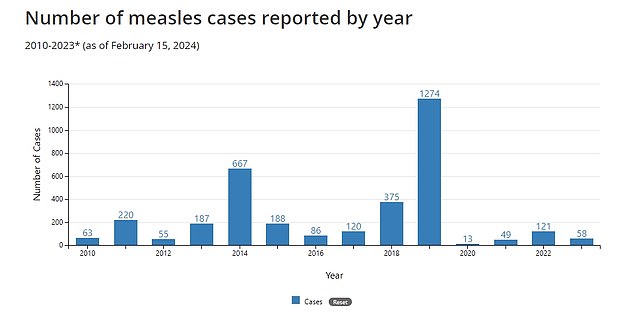Uptake of the MMR vaccine is below the safe target for the third year in a row, putting 250,000 preschoolers at risk of measles, the CDC report shows
- MMR vaccine coverage across America reached 93.1% between 2022 and 2023
- A sixth case of measles has been confirmed at a South Florida school
- READ MORE: WHO warns half of the world is at high risk of measles outbreaks
Coverage of MMR vaccines across America is below the safe target for the third year in a row.
According to the CDC, coverage dropped by another two percent between the 2019-2021 school year and the 2022-2023 school year, meaning about a quarter of a million preschoolers in the U.S. are at risk of measles infection.
The 93.1 percent rate during the 2022-2023 school year is lower than the 95 percent rate in the 2019-2020 school year, leaving measles coverage below the national goal of 95 percent for the third year in a row.
It comes as a sixth case of measles has been confirmed at a South Florida elementary school.
Cold symptoms, such as fever, coughing, and a runny or stuffy nose, are usually the first sign of measles

The above shows measles cases in the United States year after year
Exemptions from school shooting also reached a record high: more than five percent in ten states.
As of February 15, a total of twenty cases of measles were reported by eleven jurisdictions in Arizona, California, Georgia, Maryland, Minnesota, Missouri, New Jersey, New York City, Ohio, Pennsylvania and Virginia.
In the most recent outbreak in Florida, six children have tested positive for measles so far.
About 33 of the school’s 1,067 students have not received either dose of the MMR vaccine, Broward County Public Schools Superintendent Dr. Peter Licata said Wednesday.
Doctors were first notified of a case of measles on Friday, February 16 – a third-grader with no travel history.
Dr. John Brownstein, epidemiologist and chief innovation officer at Boston Children’s Hospital, told ABC News: ‘The lack of travel history in the measles cases suggests we are likely seeing local transmission, underscoring the serious risk to the community.
‘Measles is highly contagious and due to the long incubation period of eleven to twelve days, there is a good chance that more children will become infected without showing any symptoms.
“This situation is alarming and requires immediate public health intervention to prevent further spread.”
Measles is a highly contagious, airborne virus that mainly affects children under the age of five.
Since 2000, the disease can be prevented by two doses of the MMR vaccine, according to the WHO and the Centers for Disease Control and Prevention.
The recommended two doses of the MMR vaccine are 97 percent effective against measles, the CDC reports.
One dose is 93 percent effective.
But measles vaccination rates have fallen and more and more young children are going to schools unvaccinated.
Millions may have missed vaccinations during the COVID-19 pandemic, as health care systems became overwhelmed and fell behind on routine vaccinations for preventable diseases.
If an unvaccinated child is exposed to measles, an MMR injection should be given as soon as possible.
If given within 72 hours of first exposure, the injection may provide some protection against measles or reduce the severity of the disease.
